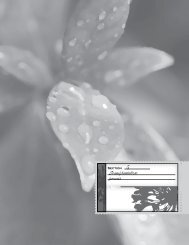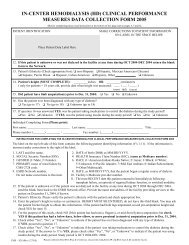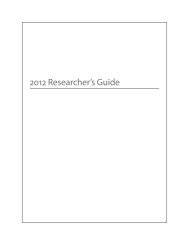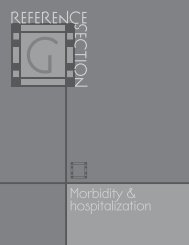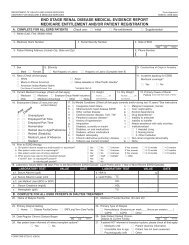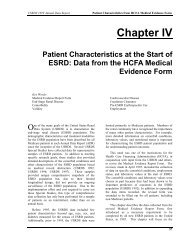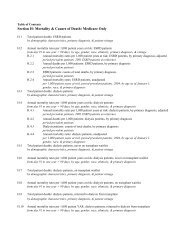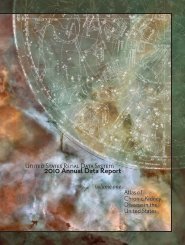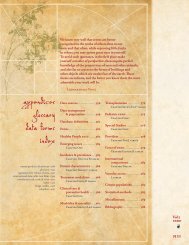Download - United States Renal Data System
Download - United States Renal Data System
Download - United States Renal Data System
You also want an ePaper? Increase the reach of your titles
YUMPU automatically turns print PDFs into web optimized ePapers that Google loves.
Introduction<br />
This Researcher’s Guide to the USRDS <strong>Data</strong>base is designed to<br />
assist those interested in using USRDS data to perform their<br />
own analyses. The following material is addressed:<br />
♦ Getting Started. Examples of datasets and steps to help<br />
start constructing analyses.<br />
♦ Section 1 ESRD <strong>Data</strong> Sources and the <strong>Data</strong>base <strong>System</strong>.<br />
General descriptions of data available to the USRDS<br />
and the processes involved in their creation.<br />
♦ Section 2 ESRD Patients. Methods used to define ESRD<br />
patients.<br />
♦ Section 3 Treatment History. Methods used to create a<br />
treatment history for each patient.<br />
♦ Section 4 Payer History. Methods for analyzing insurance<br />
payer information.<br />
♦ Section 5 Transplant Process and Outcomes. Methods<br />
for analyzing transplant patient data.<br />
♦ Section 6 Morbidity and Hospitalization. Methods for<br />
analyzing morbidity and hospitalization data.<br />
♦ Section 7 Survival and Mortality. Methods for analyzing<br />
survival and mortality data.<br />
♦ Section 8 Providers. Description of the Facility database,<br />
which contains data on US dialysis facilities.<br />
♦ Section 9 Disease-Based Cohort. Description of the<br />
DM/CKD/CHF cohort finder files by year, using the<br />
5% General Medicare Claims data and ESRD patient<br />
demographic information.<br />
The appendices include:<br />
♦ <strong>Data</strong> products and descriptions.<br />
♦ Detailed discussion of the Medicare Claims.<br />
♦ Statistical methods used by the USRDS.<br />
♦ <strong>Data</strong> files available to researchers, with data dictionaries.<br />
♦ <strong>Data</strong> formatting information.<br />
♦ Lists of data forms available at www.usrds.org: CMS,<br />
UNOS, and CDC ESRD data forms; Special Study ESRD<br />
data forms; DMMS Waves I, II, III, IV, and FACS study<br />
forms.<br />
♦ A glossary.<br />
Structure of the USRDS <strong>Data</strong>base<br />
History of the USRDS<br />
The first USRDS contract was awarded in 1988 to the Urban<br />
Institute in Washington, DC, which worked in conjunction<br />
with investigatorss at the University of Michigan at Ann Arbor.<br />
Under a new contract created in 1999, the USRDS was<br />
divided into a Coordinating Center (CC) and four Special<br />
Studies Centers (SSCs), each of which continues to operate<br />
under the direction of the National Institute of Diabetes and<br />
Digestive and Kidney Diseases (NIDDK) at the National<br />
Institutes of Health (NIH).<br />
The CC and Cardiovascular SSC contracts were awarded in<br />
1999 to the Minneapolis Medical Research Foundation, and<br />
are directed by Allan Collins MD and Charles Herzog MD,<br />
respectively. The Economic SSC was awarded to the University<br />
of Iowa under the direction of Lawrence Hunsicker MD.<br />
In 2000, the Nutrition SSC was awarded to the University of<br />
California at San Francisco, directed by Glenn Chertow MD,<br />
and the Rehabilitation SSC to Emory University, directed by<br />
Nancy Kutner PhD.<br />
USRDS website: www.usrds.org<br />
The USRDS website provides users with access to PDF files<br />
of the printed Annual <strong>Data</strong> Report (ADR), Excel files of the<br />
Reference Tables and the data underlying the graphs and<br />
state maps, and PowerPoint slides of USRDS presentations<br />
and ADR figures. Because of the size and complexity of the<br />
ADR files, downloading time for large portions of the book<br />
may be substantial; estimated times using a 56 kbs modem<br />
are provided next to the file names.<br />
CIRS (Cohort ID Retrieval <strong>System</strong>)<br />
Designed for renal researchers who have active <strong>Data</strong> Use<br />
Agreements (DUA) with the USRDS, CIRS quickly extracts a<br />
matching cohort list into a downloadable file. Using a simple<br />
query interface, users can select cohort characteristics, submit<br />
the query, and download a Comma Separated (CSV) text file<br />
containing a list of that cohort’s unique ID’s. For access, users<br />
must have a current DUA and an assigned password.<br />
Note: To use this feature or to obtain a DUA, you must have<br />
received a USRDS SAF. Contact the USRDS for further information.<br />
Phone 612-347-7776, toll free 1-888-99USRDS,<br />
fax 612-347-5878, usrds@usrds.org.<br />
CMS<br />
PMMIS/<br />
REBUS/REMIS<br />
CMS ESRD Part A SAF<br />
claims: OP, IP,<br />
SNF, HH, hospice<br />
CMS ESRD Part B SAF<br />
claims: Physician/<br />
Supplier, DME<br />
5% general Medicare SAF<br />
claims: OP, IP, SNF, HH, hospice,<br />
Physician/Supplier, DME<br />
UNOS<br />
tx<br />
data<br />
EGHP<br />
enrollment<br />
& claims data<br />
CMS<br />
EPO<br />
data<br />
CMS<br />
facility<br />
data<br />
CDC<br />
survey<br />
data<br />
NHANES<br />
Network<br />
SIMS<br />
Common Standard Re-usable Working Set Library<br />
USRDS database<br />
(1.6 million patients)<br />
ESRD<br />
cohort<br />
finder files<br />
Patient<br />
profile<br />
Modality/<br />
payor<br />
sequence<br />
Comorbidity<br />
profile<br />
Tx<br />
profile<br />
CMS ESRD & 5% general<br />
Medicare Claims data:<br />
Part A, Part B, & EPO<br />
UNOS<br />
transplant<br />
data<br />
USRDS Special<br />
Studies data<br />
Disease-specific<br />
cohort finder files<br />
(CKD, CHF, DM)<br />
EGHP claims<br />
data:<br />
Parts A & B<br />
USRDS Annual<br />
<strong>Data</strong> Report<br />
USRDS researcher<br />
SAF CDs<br />
<strong>Data</strong><br />
analyses<br />
USRDS custom<br />
data files<br />
USRDS web-based<br />
applications<br />
e<br />
Introduction



